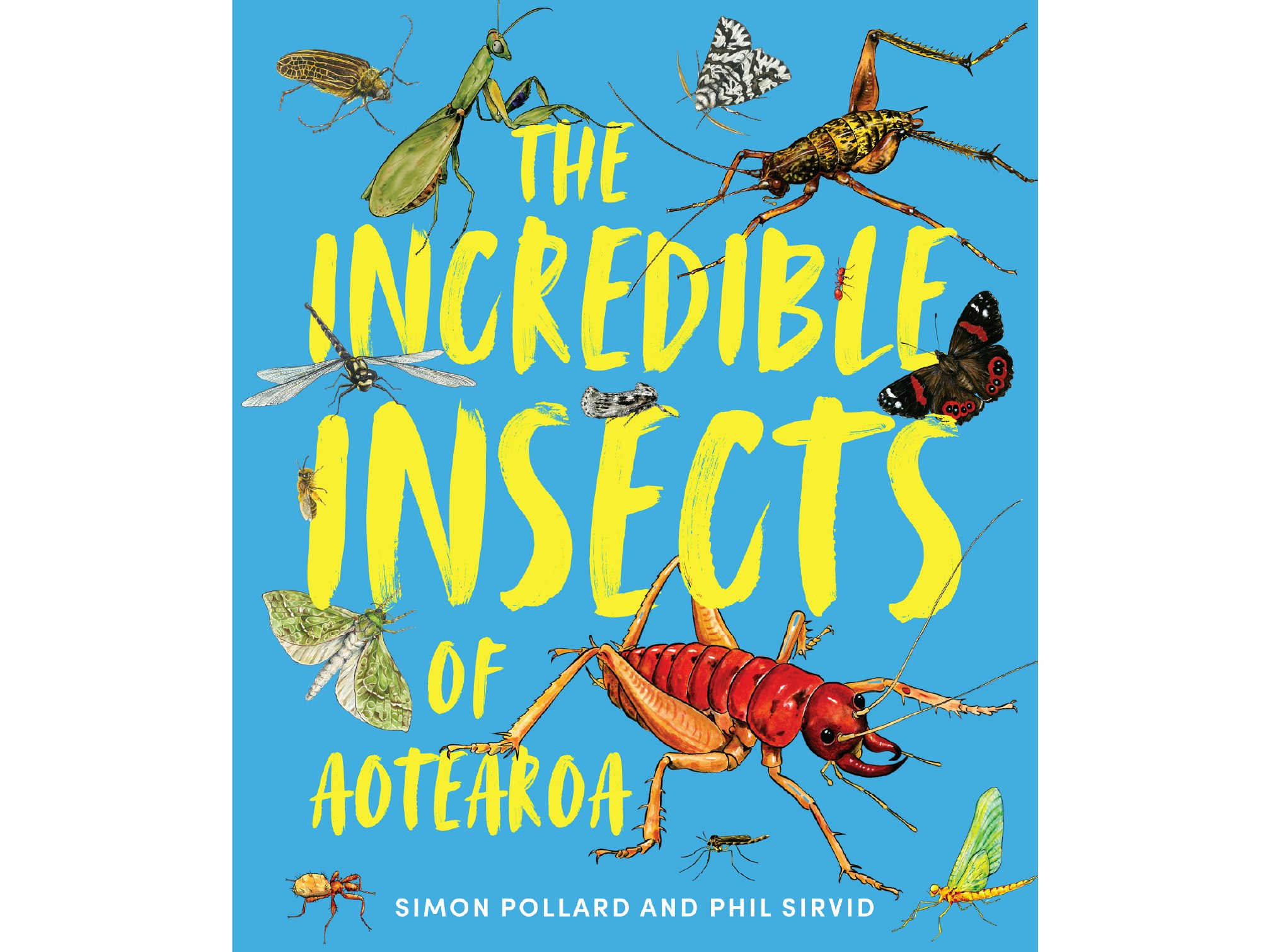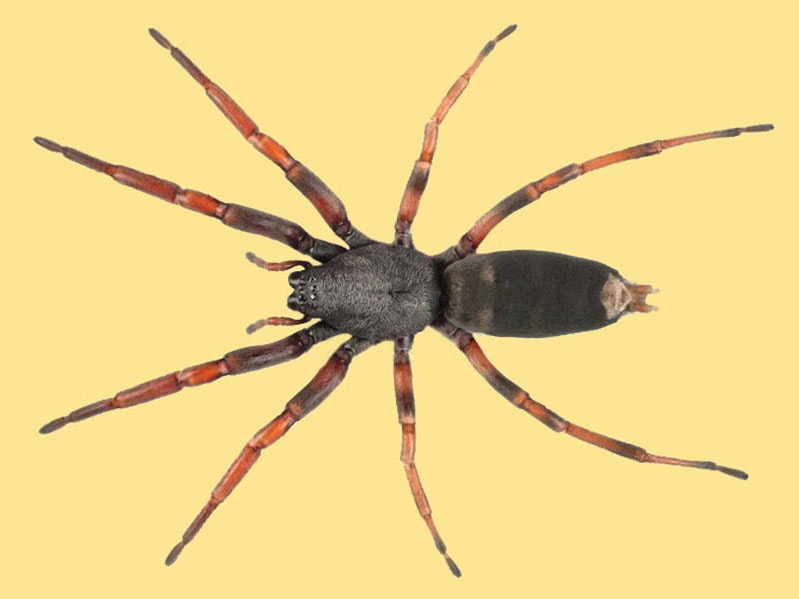
The Incredible Insects of Aotearoa
A fun, fascinating and revealing book about the strange and wonderful critters of Aotearoa New Zealand.
Free museum entry for New Zealanders and people living in New Zealand
Open every day 10am-6pm
(except Christmas Day)
Free museum entry for New Zealanders and people living in New Zealand
Simon Pollard and Phil Sirvid discuss The Incredible Insects of Aotearoa with Te Papa Press.
Dr Simon Pollard is a spider biologist and award-winning natural history photographer and writer. He has written and illustrated a number of children’s books. His previous books published by Te Papa Press, are Why is That Spider Dancing? (2021) co-written with Phil Sirvid and short-listed for the New Zealand Book Awards for Children and Young Adults, Why Is That Lake So Blue? (2018) and The Genius of Bugs (2017), also shortlisted for the Children’s book awards. Simon has also been an advisor, scriptwriter and presenter on a number of natural history documentaries, including the BBC’s Planet Earth. Since 2009, Simon has been Adjunct Professor of Science Communication at the University of Canterbury.
Dr Phil Sirvid is Curator Invertebrates in the Natural History Team at Te Papa. Phil has looked after the insect and arachnid collections and been involved in science outreach at Te Papa for over 30 years. He has contributed to the Te Papa Press titles Why is That Spider Dancing?, 100 Natural History Treasures of Te Papa, and Nature—Stilled, and more recently co-authored Native Insects of Aotearoa – part of the Te Papa Te Taiao Nature Series. Along with Simon, Phil has also curated the blockbuster science exhibition Bug Lab.
Phil Sirvid: In my case, I got bitten by the nature bug (pun intended!) when I started school. We had a nature table, and we were rearing gum emperor caterpillars. These are quite large and impressive, and I was hooked! For me, it just made sense we would want to introduce people to some of our favourite insects, so when Simon suggested it, I didn’t need any convincing.
Simon Pollard: As well as spiders, I was always fascinated by the lives of insects. It was an easy decision to change focus from writing about the amazing arachnids of Aotearoa to writing about the incredible insects of Aotearoa. Also, the team at Te Papa Press are fantastic to work with, so I was very pleased to have the opportunity with Phil to write about our insects.
SP: Aotearoa has many more species of insects than arachnids. This meant we had a huge range of stories to choose from, and we wanted to give readers an idea of the amazing lives our insects lead. We also wanted our wonderful wētā to be a feature of each chapter.
PS: In many ways, the structure of the book is similar, but yes, there are differences. Our cover is very different for one thing, showcasing some of Lily Duval’s ‘Bug of the Year’ art. More on that topic later! We also have more experts telling us about how they are inspired by these amazing creatures, and more Mātauranga Māori, thanks to contributor Ocean Mercer.
PS: I think if you asked New Zealanders to name an iconic New Zealand insect, most would pick wētā. Of course, there are many kinds of wētā, many of them large and spectacular. Even the tree wētā that are common in backyards are pretty impressive. And while insects like our wētā are found in other countries, I think they are more in the minds of the public here than anywhere else.
SP: Many wētā look like grasshoppers dressed as gladiators, and almost all of them are only found in Aotearoa. Their size and startling appearance make them as iconic to Aotearoa as kiwi, kākāpō and tuatara.
SP: We are very lucky to have so many insect experts in Aotearoa that love the insects they study as much as people love their pets. Whether it’s stick insects, giraffe weevils or glow worms, they are very special animals to the people who study them. We are also very pleased they were keen to share their stories about how insects became such an important part of their lives. I’m sure some readers will be inspired to ‘catch the insect bug’.
PS: We have experts from around Aotearoa who are passionate about the insects they love most, whether that’s wasps, wētā, weevils or something else. We also have experts talking about Mātauranga Māori, insect art, the citizen science platform iNaturalist NZ and photography.
PS: There are THOUSANDS of insect species yet to be discovered and named by scientists right here in Aotearoa. It’s a monumental task, but even then, that’s just the start. We know so little about how most of them live their lives.
SP: I think most people would not know how many different insects live in the alpine regions of Aotearoa. I’m also sure most people don’t know that about 90% of the insects found in Aotearoa are found nowhere else. Fortunately, there are a number of conservation projects to make sure they have a safe place to live. Also, the ‘Bug of the Year’ competition lets people vote for their favourite bug and the winner each year reminds us of what a special place we and Aotearoa’s bugs live in.
PS: Some of the images in this book are from Simon and I, but we have some spectacular images from my old friend Bryce McQuillan who provided many incredible images for Why is That Spider Dancing? We also have lots of wonderful photos from many amazing photographers who have posted their images on the citizen science website iNaturalistNZ and were willing to share them with our readers.
SP: We were also very lucky to be able to use excellent photographs from a number of photographers. I am very pleased that some of my photographs of insects featured in the book and I’m especially proud of my photographs of a fierce-looking West Coast wētā and a praying mantis eating a spider leg (see sample pages).
PS: It is an annual competition run by the Entomological Society of New Zealand and is intended to raise awareness of our amazing insects, spiders and other small and often overlooked creatures. Voting starts Jan 1 each year and ends in mid-February. Our first two winners were the native bee and the red admiral butterfly and as I am writing this, our third edition of ‘Bug of the Year’ is up and running. Every year, Lily Duval, who illustrated the book’s cover and is featured inside as an expert, produces a beautiful poster showing off all the nominees. Anyone interested in learning more, including making a nomination for the next edition, can go here for more information: bugoftheyear.ento.org.nz
PS: It’s hard to put an exact figure on it, but it’s hundreds of thousands of specimens. The collection has specimens from the late 1800s to the present day, and it includes examples of every insect order (as well as spiders, centipedes, and other arthropod groups) from all over the country. We also have a sizeable collection of exotic insects that have been donated to the collection over the years. We have a large collection of dry pinned specimens, but there are also many soft-bodied specimens stored in ethanol, and very tiny specimens that are mounted on slides for microscopic examination.
The collection is not just a scientific record of Aotearoa’s insect life made over nearly a century and a half. It has also inspired artists, and new technologies are allowing specimens to be studied in ways that early entomologists could not have dreamt of. And of course, insects from the collection feature in Te Papa’s exhibitions.
SP: That the lives of our insects are just as fascinating as the lives of much bigger animals like birds and mammals. Ants are just as interesting as elephants and giraffe weevils are as interesting as giraffes. I hope that after reading our book people will appreciate the lives of these creatures living among us.
PS: Most of Aotearoa’s insects are found nowhere else on earth. That’s amazing to me, and I’d love people to share that sense of just how unique and special our insects are. It would also be wonderful if the book inspired readers to start seeing insects as the incredibly complex little marvels that they are instead of reaching for the fly spray! Ultimately, we’d love people to catch the ‘bug’ for bugs, as Simon and I have!
PS: As I said earlier, there are many species still awaiting discovery, right here in Aotearoa, and there is still so much to learn about what they do. But insects have many secrets to share that humans can directly benefit from. For example, did you know that dragonfly wings are antiseptic and the way they are constructed has inspired scientists to design safer food packaging?!
SP: Thanks to the research of scientists working with insects in Aotearoa, I learnt so much while writing this book. So many of their discoveries rely on technology that allow them to peer into their lives in ways that were not possible in the past. Whether it’s understanding how an alpine wētā can survive being turned into an ice cube or how a forest wētā can hide underwater, they seem like stories beyond your imagination. And to think the frosted phoenix, a moth last seen in 1959, was photographed on a veranda in 2024. It’s good to know there are so many more insect stories out there, just waiting to be discovered.

A fun, fascinating and revealing book about the strange and wonderful critters of Aotearoa New Zealand.

Insects, arachnids, myriapods, bugs, creepy-crawlies, moths, butterflies and their allies.